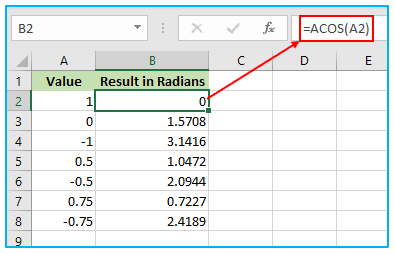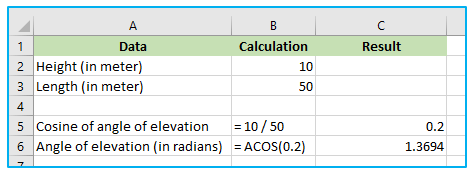ACOS function in Excel enables users to compute the arccosine, i.e., the inverse cosine of a value. This function comes in handy for trigonometric calculations, especially when dealing with angles. By using the ACOS function, users can determine angles based on cosine values, which is particularly useful in fields like engineering, physics, and mathematics. Integrating the ACOS function into Excel spreadsheets facilitates accurate angle computations, enhancing the precision of various analytical tasks. Whether working on geometric problems or engineering projects, having the ACOS function readily available in Excel ensures efficient and reliable angle calculations, contributing to smoother workflow and better decision-making processes.
This Tutorial Covers:
- What is ACOS Function
- Syntax of ACOS Function
- Arguments of ACOS Function
- Returns of ACOS Function
- Applies To
- Usage notes
- Where can the ACOS function be used
- Excel ACOS Function Examples
- Example of ACOS Function in Excel
- ACOS Function Errors
1. What is ACOS Function?
The arccosine of an integer is returned by the Microsoft Excel ACOS function (in radians).
The Excel built-in function ACOS falls under the Math/Trig Function category. The Excel worksheet function (WS) allows for its utilization. The ACOS function can be used as a worksheet function and entered as a component of a formula in a worksheet cell.
-
Syntax of ACOS Function:
The syntax for the ACOS function is as follows:
=ACOS(number)

-
Arguments of ACOS Function:
The following argument is used by the Excel ACOS function:
number – the quantity to calculate the inverse cosine of. It has to fall somewhere between -1 and 1, inclusive.
-
Returns of ACOS Function:
A numerical value is returned by the Excel ACOS formula.
-
Applies To:
A few examples of Excel versions are Excel for Office 365, Excel 2019, Excel 2016, Excel 2013, Excel 2011 for Mac, Excel 2010, Excel 2007, Excel 2003, and Excel XP.
2. Usage notes:
The inverse cosine of a value is the result of the ACOS function. The range for the arc-cosine function’s input is from -1 to 1, inclusive. Geometrically, the function returns the angle of the triangle given the ratio of a triangle’s adjacent side over its hypotenuse. For instance, the function returns the angle of 1.047 radians for a ratio of 0.5.
3. Where can the ACOS function be used?
The ACOS function in Excel can be used in various applications where the angle whose cosine is given needs to be calculated. Here are a few examples of where the ACOS function can be used:
Trigonometry: The ACOS function is commonly used in trigonometry to find the angle whose cosine is given. It can be used to calculate angles in triangles or other shapes.
Engineering: The ACOS function can be used in engineering calculations where the angle between two vectors or the orientation of a component needs to be determined.
Physics: The ACOS function can be used in physics to calculate the angle between the velocity vector and the acceleration vector of a particle.
Mathematics: The ACOS function can be used in various mathematical calculations, such as calculating the distance between two points in three-dimensional space.
Data Analysis: The ACOS function can also be used in data analysis to calculate the similarity between two vectors or to normalize data.
4. Excel ACOS Function Examples:
The Excel ACOS Function is demonstrated in the spreadsheet below, which computes the arccosine of four different numbers.

5. Example of ACOS Function in Excel:
Suppose an engineer is designing a bridge and needs to calculate the angle of elevation of the bridge deck. The engineer can use a clinometer or inclinometer to measure the vertical angle between the ground and the bridge deck. However, this angle is measured in degrees, and the engineer needs to convert it to radians to use in calculations.
The engineer can use the ACOS function in Excel to convert the angle from degrees to radians. The engineer knows that the cosine of the angle of elevation is equal to the ratio of the height of the bridge deck to the length of the bridge. The engineer can measure the height and length of the bridge and calculate the cosine of the angle using the following formula:
cos(θ) = height / length
where θ is the angle of elevation.
The engineer can then use the ACOS formula in Excel to calculate the angle of elevation in radians:
=ACOS(height / length)
Here is a table that summarizes the data and calculations:

The engineer can now use the angle of elevation in further calculations for the bridge design.
6. ACOS Function Errors:
The Excel Acos function issue is most likely going to be one of the following:
#NUM! – occurs when a number argument that has been supplied is outside the range of -1 to +1.
#VALUE! – occurs when a non-numeric number argument is given.
Application of ACOS Function in Excel
- Trigonometric Calculations: ACOS function in Excel is primarily used to calculate the arccosine of a given value, which represents the angle whose cosine is the specified value.
- Angle Determination: It helps in determining angles based on cosine values, which is crucial in various fields like geometry, physics, and engineering.
- Inverse Trigonometric Calculation: ACOS function serves as an inverse to the COS function, enabling users to find angles when cosine values are known.
- Precision in Angle Calculations: By using ACOS, users ensure accuracy in angle computations, which is essential for tasks requiring precise measurements.
- Engineering Applications: In engineering disciplines such as structural analysis or mechanical design, ACOS aids in determining angular relationships for accurate modeling and analysis.
- Mathematical Modeling: ACOS is integral for mathematical modeling where trigonometric functions are involved, ensuring precise solutions in Excel spreadsheets.
For ready-to-use Dashboard Templates:
